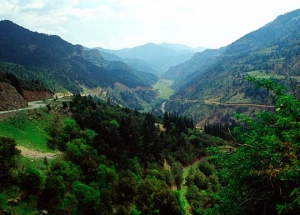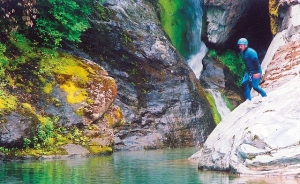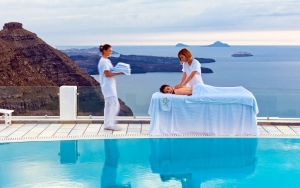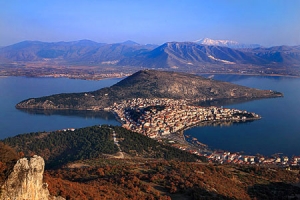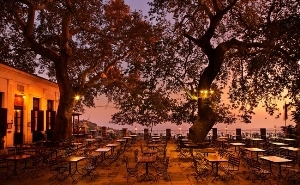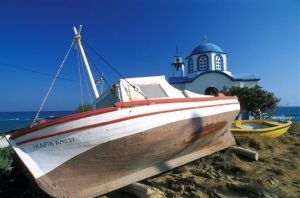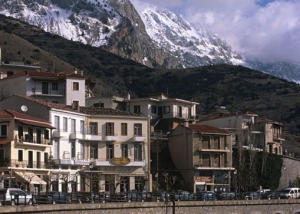Where: Aráchova is a mountainous village nestling picturesquely at the foot of Mt. Parnassós in Viotia, Southern Greece. Why: Because it is the most cosmopolitan winter destination in Greece, a great favourite for passionate ski lovers and celebrities, or just first-time visitors who wish to relax in a dreamy mountainous setting with modern tourism facilities.
Its modern ski resort, its close proximity to Athens, and its breathtaking mountainous landscape are the strongest reason why. Apart from the mountain activities, Aráchova is also famous for its bustling nightlife!
Must visit: The Byzantine churches of the village with their well preserved frescos.
Activities on offer: Get involved in outdoor activities such as hiking or ski down the slopes of Mt. Parnassós at the biggest downhill ski resort in Greece. The mountain’s high altitude offers ski lovers long-lasting snow cover at the peaks.
Hot tips:
• Discover the traditional character of the village by taking leisurely walks through its narrow cobblestone streets. Enjoy hot and sweet or soft and fruity drinks in cafés, or traditional kafeneia (coffee shops).
• Stay up all night and enjoy the village’s bustling nightlife. There are a plethora of bars and clubs up and down the streets of Aráhova.
• Visit the nearby archaeological site of Delphi.
Accommodation: Various elegant first-class hotels or traditional guest houses offer luxurious accommodation.
Famous local products: Aráhova offers a memorable gourmet experience; taste local specialties: kontosoúvli (big hunks of pork skewered and put on a rotisserie with onions, tomatoes, peppers and seasoned with salt and pepper, garlic and oregano), kokorétsi (the intestines of the lamb stuffed with offal), sarmádes (stuffed grape leaves), traditional pies, handmade trahanás (pasta soup, can be sweet or sour), and hilopites (egg noodles made in linguine-sized strips, cut into small pieces).
Aráhova also produces the famous cheese “formaéla”, a sweet smelling hard rind cheese of with a relatively mild flavour that you should definitely taste!
Have a sip of the divine Parnassós local wine, the red “Mavroudi”, which achieved Protected Designation of Origin status in 2006. The “Black Aráhova vine” is a full-bodied prolific variety that produces wines of a deep red hue with a high alcohol content.
Complete your meal with traditional “spoon-sweets”, or even better, try yogurt with honey, a dessert served compliments of the house. Before you leave Aráhova, pick up some hand-made beautifully coloured woven carpets (flocati rugs) and textiles to take with you as a going-away present.
Karpenissi
Where: A mountain village situated in Evritania, Greece.
Why: Towering snow capped mountains; deep ravines; fast-flowing rivers and lakes; impressive gorges; Byzantine monasteries and tiny mountain villages make out an form an alpine landscape that promises to offer the ultimate winter experience!
Must visit: The most popular sights of Karpenissi: The Byzantine Church of Agia Triada in Karpenissi, the Church of Panagia in Fousiana, Agia Paraskevi in Vraggiana and Proussos Monastery, the Library and the picturesque squares of Markos Botsaris and Katsantonis, both famous heroes of the Revolution.
Activities: Trekking along winding mountain paths; canoe-kayaking in Kremaston Lake; kayaking and rafting down the Aheloos, Tavropos and Trikeriotis rivers; horse riding; canoeing through the gorges of Viniani and Vothonas; jeep safari and skiing at the modern ski resort of Karpenissi, one of the biggest and most popular in Greece.
Follow scenic routes and admire the undulating natural surroundings. Two suggested routes are: Karpenissi - Gorgianades - Korishades - Klausi - Voutiro - Nostimo - Megalo Horio - Mikro Horio - Palio Mikro Horio – Proussos and Karpenissi - Viniani - Kerasohori - Marathos - Monastiraki - Epiniana - Agrafa - Tridendro - Trovato - Vraggiana – Agrafa.
Hot tip: Visit the beautifully preserved district of Korishades and tour its fascinating museums such as the National Resistance Museum; visit restored manor houses, Byzantine churches, schools transformed into museums and the arched bridges of the area, wonderful examples of local architecture.
Accommodation: Choose from among family run pensions, welcoming guesthouses or luxurious hotels!
Famous local products: Taste fried trout and mushrooms (morchella) in red sauce. Other exquisite local products on offer include Katiki, which is a Euritanian goat cheese, feta cheese, yoghurt and butter, local meat, beans, noodles, pasta, chestnuts and walnuts, berries, black cherries, crab apples, figs and kumquats, honey and superb “spoon sweets” as well as wine, tsipouro and liqueurs. Don’t forget to buy folk art products, like handmade rugs and woven fabrics of exceptional quality.
To read more, please see visitgreece.gr



